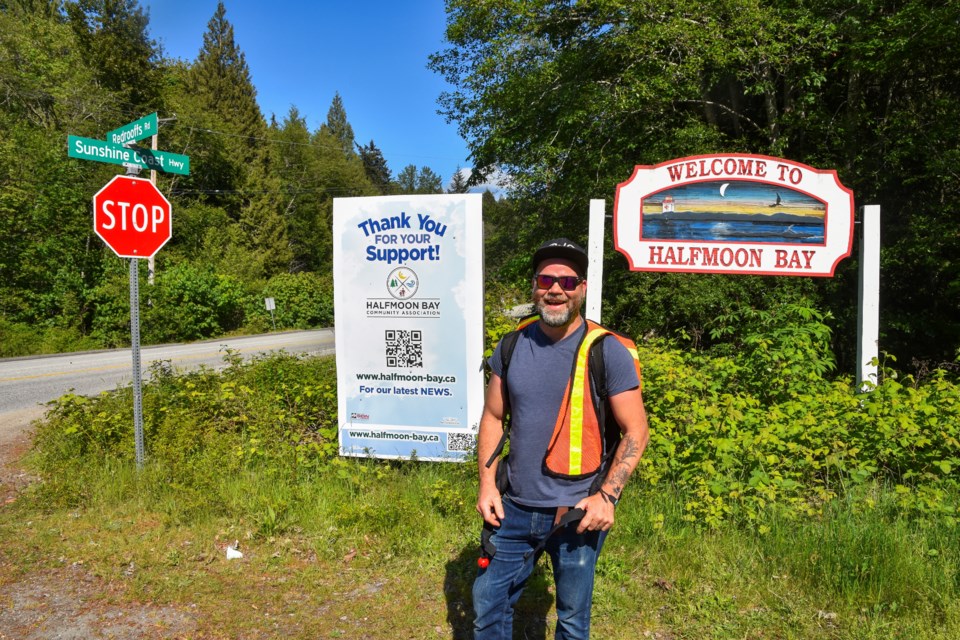While many people aim to hit 10,000 steps a day, one Sunshine Coast man did over six times that to raise awareness of transit deserts in the area.
While much of the southern Sunshine Coast is accessible by bus and other transit services, once you’re north of Halfmoon Bay, you’re on your own.
On May 19, Chris Hergesheimer walked from Egmont to the north end of Redrooffs Road (roughly 50 kilometres), where the transit bus stop is, showing the distance someone would have to travel without a car.
Hergesheimer is trying to inspire a conversation about better connectivity on the Coast.
“It’s not a local government thing, it’s not a BC Transit thing,” said the Halfmoon Bay resident, who is a well-known advocate on the Coast. “It’s just asking questions of our community, like, ‘How can we better connect these areas that are under-serviced into our whole region?’”
While Hergesheimer did the trek of his own accord, it’s not far from his professional interest. Hergesheimer leads the Sunshine Coast Resource Centre’s Poverty Reduction Project. The project’s Be The Change campaign recognized May as access to transportation month.
A downfall of areas with limited transportation or transit deserts is they can discourage young families from moving into the area, as the cost of owning a vehicle continues to increase, Hergesheimer shared.
Saying that a lack of transit affects people in all stages of life, Hergesheimer also highlighted that elderly residents who stop driving can lose much of their ability to visit friends or loved ones.
Creative solutions may be the answer, said Hergesheimer, like collective vans that run on commuting times and business hours so people could get to the hospital or other appointments.
It’s more than helping people get out of the remote areas, Hergesheimer said. It’s also about allowing people without a car to travel into the area.
“If you could jump a bus in the summer and ride up to Ruby Lake or something for the day and know that you could hang out with your buddies and get on a bus at five or six o’clock and get back to Sechelt, it would be a game changer for those younger kids,” he said.
Aside from the vast distance, there are dangers to walking the length of the Sunshine Coast Highway and Hergesheimer would not recommend it as a safe mode of travel, citing certain areas of the highway where there isn’t room for a pedestrian to safely walk next to passing cars.
Reiterating that nothing about his walk was meant to assign blame and that it was more about planning for the future, he said, “As a community, we need to be keeping this on our radar and having that conversation.”
The walk took Hergesheimer 10 hours on the dot. He said despite a few blisters the walk was easier than he originally expected.
He said walking from Egmont gave him a unique perspective of the “single-occupancy-car-dominated stretch of highway,” as he passed everything much slower and saw it in greater detail.
He said the section between Middlepoint and Madeira Park was the most dangerous in terms of space for a pedestrian, adding that he had to step out over the concrete barricades at some of the more winding sections of the road and walk along the outside.
While Hergesheimer was proud of his accomplishment, he reiterated that it is not a viable way for people to move up and down the highway. He took several safety precautions, such as wearing a reflective vest and planning his walk for a bright weekend day.
Recognizing that transportation is a multi-faceted topic, affecting safety, timing, infrastructure and multi-sector partnerships, Hergesheimer said he’s simply hoping to keep the conversation going.
Waiting for Hergesheimer at the end of his trek was his very proud father, with a cold drink and a comfortable chair ready for his son.
Jordan Copp is the Coast Reporter’s civic and Indigenous affairs reporter. Made possible by the Local Journalism Initiative



